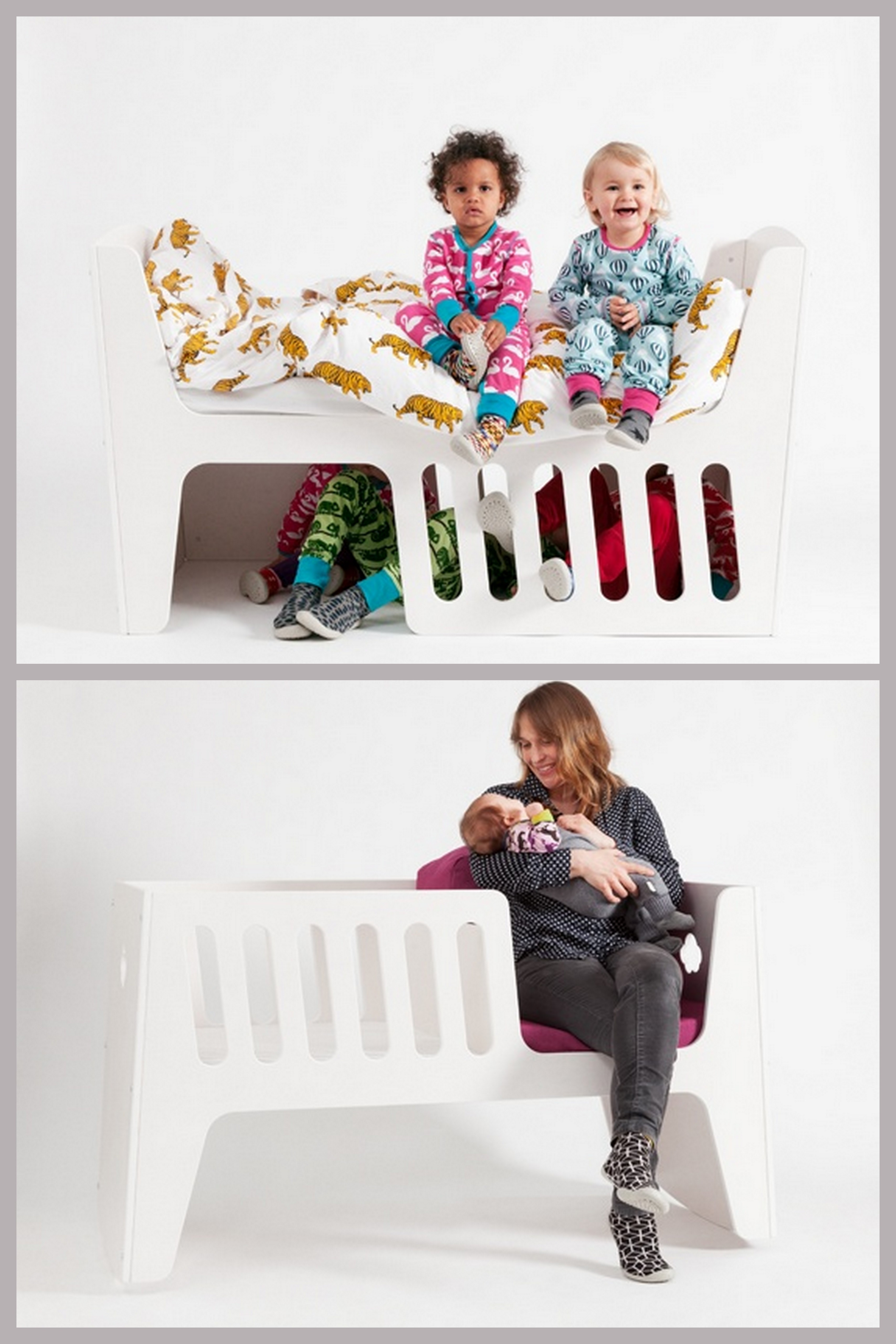 When the Planetas first moved into their 850-square-foot Seattle home, it felt perfect for their family of three. But when that family grew to four, the parents suddenly found the baby sleeping in their room, a changing table in the dining room and toys everywhere. Now they spend nearly every night cleaning up just to feel like their house has some order, and suddenly there doesn’t seem to be an “adults only” zone in the whole place — including their bedroom.
When the Planetas first moved into their 850-square-foot Seattle home, it felt perfect for their family of three. But when that family grew to four, the parents suddenly found the baby sleeping in their room, a changing table in the dining room and toys everywhere. Now they spend nearly every night cleaning up just to feel like their house has some order, and suddenly there doesn’t seem to be an “adults only” zone in the whole place — including their bedroom.
According to the 2010 U.S. Census, the average American home is 2,392 square feet, but raising a family in a small space isn’t a lost art. With the rise of “micro-apartments” (smaller than 300 square feet) and concerns about sustainability in most major U.S. cities, small-space living is a growing trend for modern families.
Cutting down to size
Of course, downsizing isn’t easy. When Sarah Butler and her family of five went from more than 3,000 square feet in Oregon to just over 1,000 square feet in San Diego to be within walking distance of the beach, she confesses that she was a little freaked out about how they’d survive.
“Stuff is always everywhere. If one person leaves their shoes out, it’s not that big of a deal. If all five of us do, it’s a tripping hazard,” Butler says. “Add the backpacks, books, lunchboxes and a thousand tiny Lego parts that somehow manage to float out of the bedroom, and you have a recipe for disaster or insanity.”
But three years in, the Butlers have decided to stay in their new home. This surfing family loves their neighborhood, and they’ve come to appreciate the forced proximity.
“Living this small with this many people is not easy, and probably not for everyone. We know that there are frustrations and stress that happen on a daily basis that would not be happening if we weren’t right on top of each other all the time,” says Butler. “However, we simply feel that the benefits outweigh the cost for us. We like being together — most days — and we feel like it’s good for our kids to learn how to live in close quarters.”
For the Planeta family, a larger space would come at a greater cost, which would likely mean a big change in the life they love right now.
“I feel very lucky to be able to stay at home with my kids,” says Jennifer Planeta. “I wouldn’t trade a bigger house for that, ever. This is temporary, and we are smart and flexible people who are hopefully teaching our kids about bigger and deeper values in life through living in close quarters.”
Thinking of these perks helps when the space feels suffocating, the kids are fighting about their shared room or the family is purging yet another round of stuff. Other sanity measures include getting outdoors, looking for multifunctional furniture, editing your purchase decisions and finding great storage solutions. (See below for ideas!)
Getting a little closer
Adjusting your state of mind also helps. The Evelands lived with two small kids and a dog in a typically diminutive New York City apartment, but they figured that was just how it was in the city.
“If I’d known a life that didn’t involve toting two small kids, four bags of groceries and a week’s worth of laundry up four flights of stairs into a 700-square-foot apartment, it might have made me crazier,” Jennifer Eveland says.
Sometimes shared rooms and close quarters are a deliberate choice. Heather and Carlos Whittaker’s three kids don’t need to share a room in their Nashville home, but they do, because living close and learning to deal with each other is a family priority.
“I firmly believe that we are meant for community and living together. I 100 percent love that they share a room,” says Heather Whittaker of her son and two daughters. “If they need privacy, they can change in the bathroom. They can go to another room if they want alone time. The truth that they will need to learn to work with different types of people begins now.”
The Whittaker kids, ages 8–12, share not only a room but also an unusual sleeping setup. To free up floor space in the kids’ bedroom, Heather and Carlos built a three-way bunk in the bedroom closet.
The younger Whittakers love the bunks, but sometimes their mom wishes they had room for real separate beds. And sometimes her kids wish they had their own rooms, too: The oldest wants to be free to make a mess, the middle daughter wants things neat and tidy, and the son just wants space to be an active boy. But Heather says this closely woven life is what she and Carlos feel is right for their family.
“I want to teach my kids that simple is better and less is more,” she says. “I don’t know the stats, but I’m confident the majority of cultures have entire families in one room, so I think we are doing pretty well.”
Creating your new normal
Inspired by the Whittakers, their friends the Hales decided to put all three daughters in one bedroom and leave the second bedroom for toys and art supplies. The girls sleep in a modified bunk bed with a trundle-like pullout bed underneath. The other room has a queen bed for guests to use, and the girls get to sleep in it on special occasions, such as their birthdays.
Yes, the girls stay up late chatting, and sometimes the tight space leads to squabbling. But the Hales love running into each other all the time, staying close and not feeling like they have anything to prove.
“Your family’s normal doesn’t have to be the same as another family’s normal,” explains Brian Hale, who faced a slowdown in his business that led his family to rent out their home and live with relatives until they could pay off debts. “To share a room isn’t a punishment, it’s an adventure. It’s a chance to be closer,” he says.
“That time in our life greatly influenced our views on family, and want versus need. The big house and big mortgage with everyone tucked behind closed doors just isn’t appealing to us anymore.”
Thinking small
Practical tips for staying sane — and happy — in tighter spaces:

Store smart. Furniture outfitted with built-ins and added storage is a great way to utilize and free up your space. Using matching baskets, bins or crates can give toy storage a streamlined and style-forward look.
Think vertical. Kam Martin has been planning vertical storage for every room in her house. The family dining room boasts floor-to-ceiling storage that now serves as a dining room/office/sewing space that includes additional kitchen, art and book storage.
Embrace the purge. Whether minimalism is your thing or not, living small means you need to constantly pare down and reassess your possessions. Of course, some things simply can't go — but the fewer precious items you have, the better.
Get outdoors. Using outdoor space and just plain getting out into your community was something most families we talked to recommended. The Butlers created an outdoor grill area–slash–living room that even includes a TV. “We make the most of our outdoor space. It has been a lifesaver when we entertain or the kids have friends over. It really is all the difference,” says Sarah Butler.
When it comes to decorating: edit, edit, edit. “When I'm out shopping, I realize that anything that comes into my home has to replace something," Butler says. “So if I don't love it enough to boot out what I already have, it doesn't come home with me.”
Tidy up every day (maybe multiple times a day). “I usually spend some of my day organizing and sorting. Everything has to have a spot so it can get out of the lane of traffic. If it doesn't have an 'away' spot, it usually has to go,” Martin says.
If the kids don’t have much in the way of personal space, make some. Allow them to create a fort with blankets over two chairs, a cardboard box with a pillow inside it, etc., where they can listen to music, eat a meal, do homework and have time away from sibs and parents.











